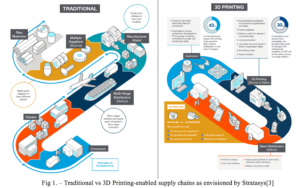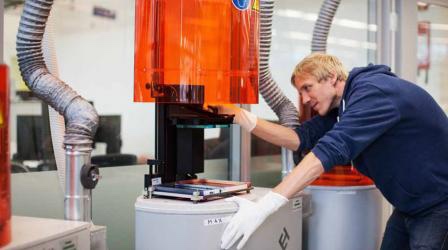A recent study in the Journal of International Economics argues that additive manufacturing (AM) has had “positive and significant effects” on international trade for a number of sectors that have adopted the technology. Apparently, this is the first time that research on 3D printing’s impact on trade has been published in an academic journal.
The paper, titled “Is 3D printing a threat to global trade? The trade effects you don’t hear about,” is coauthored by Caroline Freund, an economist as well as the dean of the University of California, San Diego (UCSD) School of Global Policy and Strategy, along with Alen Mulabdic and Michele Ruta, two economists at the World Bank. Freund was also previously the World Bank’s global director of Trade, Investment and Competitiveness.

The study primarily focuses on hearing aids, the sector where AM has dominated the greatest share of the market thus far. At this point, 99 percent of the planet’s hearing aids are estimated to be printed, and the percentage has been about that high for some time now.
Thus, hearing aids can presumably give us the clearest picture of what happens to international trade in a sector, once it has adopted AM. Freund, Mulabdic and Ruta found that hearing aid exports rose around 80 percent in the places where the technology was adopted. The researchers also studied 35 other export products in other sectors that have begun to use AM, including prosthetics, aerospace, and footwear, and found similar results.
According to the study’s abstract, “These [positive and significant effects on trade] are stronger for more complex and lighter goods. The results counter widespread views that 3D printing will shorten supply chains and reduce trade.” In the study, Freund wrote, “Policymakers often view 3D printing as a means to shorten supply chains, when in fact it is more likely to enhance trade and reshape supply chains.”

I think that very last point, concerning the potential for the technology to reshape supply chains, is the most important takeaway from the study. Lately, this is the attribute of AM that the industry as a whole has been staking itself on most, so having hard evidence of that is both crucial, as well as likely to spur further investigation into the same topic.
More broadly, beyond the purely academic implications, the fact that this can be taken as a sort of position paper on AM from the World Bank is perhaps of greater significance than the specifics of the study itself. This may seem overly simple, but I think that if the World Bank is praising something, it has a better chance of succeeding than most other developments.
Subscribe to Our Email Newsletter
Stay up-to-date on all the latest news from the 3D printing industry and receive information and offers from third party vendors.
Print Services
Upload your 3D Models and get them printed quickly and efficiently.
You May Also Like
The Dental Additive Manufacturing Market Could Nearly Double by 2033, According to AM Research
According to an AM Research report from 2024, the medical device industry, specifically in dentistry, prosthetics, and audiology, is expected to see significant growth as these segments continue to benefit from...
Heating Up: 3D Systems’ Scott Green Discusses 3D Printing’s Potential in the Data Center Industry
The relentless rise of NVIDIA, the steadily increasing pledges of major private and public investments in national infrastructure projects around the world, and the general cultural obsession with AI have...
AM Research Webinar Explores Continuum’s Sustainable Metal Additive Manufacturing Powders
Metal additive manufacturing (AM) powder supplier Continuum Powders is working to develop solutions that empower industries to reduce waste and optimize their resources. An independent life cycle assessment (LCA) of...
3D Printed Footwear Startup Koobz Lands $7.2M in Seed Round
California-based Koobz is focused on reshoring the U.S. footwear supply chain with advanced manufacturing processes, including 3D printing. The startup just announced that it has added $6 million to its...
































